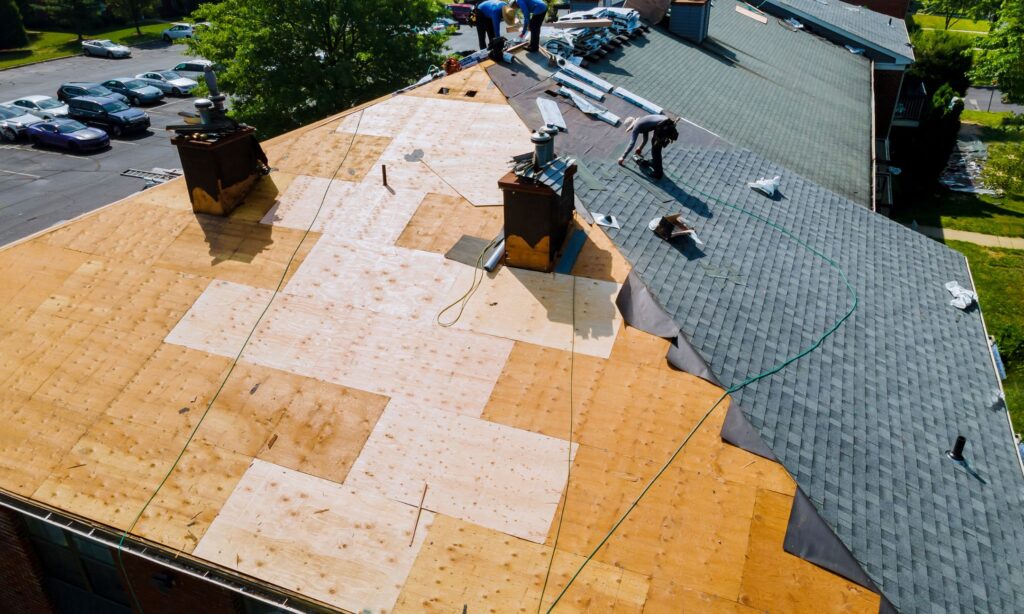Your roof is one of the most important assets of your home. It shelters you from outside elements and protects your family and belongings. However, over time, roofs can develop leaks due to wear and tear, improper installation, storms, and other issues. Many homeowners are not aware of subtle early warning signs of roof leaks. Being vigilant and addressing problems early can help prevent extensive damage and expensive repairs down the road. This article outlines 7 roof leak early warning signs that every homeowner should know.
Roof Leak Warning Sign 1: Algae and Mold Growth

In warm, humid climates, you may notice dark green or black spots on your roof. This indicates algae or mold growth, which thrives in damp environments. While a small amount is normal, excessive growth suggests moisture is getting trapped under your shingles and flashing. This dampness can degrade roof materials and lead to leaks over time. At the first sign of heavy algae or mold, contact a professional roofer to inspect and treat the growth.
Roof Leak Warning Sign 2: Buckling or Curling Shingles
Properly installed asphalt shingles should lie flat on your roof. If you notice edges starting to buckle up or curl, it often means the roof deck or underlayment is failing, allowing moisture underneath. Buckled shingles are more prone to wind damage. Curled edges also create openings for water intrusion. Have buckling and deformities assessed right away before leaks develop.
Roof Leak Warning Sign 3: Missing or Damaged Shingles
After a storm or high winds, do a thorough inspection of your roof. Look for any missing, cracked, or broken shingles. Even one compromised shingle can allow water seepage over time. also check flashing around chimneys, skylights, and vents for damage. Promptly replace individual damaged shingles and repair flashing to prevent leaks.
Roof Leak Warning Sign 4: Excessive Granule Loss
Asphalt shingles contain mineral granules on the surface that protect their waterproof core. Some granule loss over your roof’s lifetime is normal. However, excessive missing granules can indicate advanced aging and deterioration of the shingles’ core. Have an inspection to determine if full roof replacement is needed when you notice significant balding and loss of protective granules.
Roof Leak Warning Sign 5: Stains on Interior Ceilings and Walls
If you notice new water stains on ceiling drywall or interior walls around roof edges, it likely signifies an active leak. The stain may not align directly with the leak since water can travel along rafters. Even small leaks can lead to major damage over time. Have the roof immediately examined whenever new interior stains appear to pinpoint and repair the source.
Roof Leak Warning Sign 6: Debris Accumulation in Gutters
Clogged gutters can back up and allow water to pool on your roof instead of properly draining. This excess moisture can lead to leaks, especially around vulnerable areas like vents. Make sure you regularly clean out gutters and check that downspouts are clear. Promptly fix any sagging or disconnected parts of the gutter system.
Roof Leak Warning Sign 7: Attic Moisture and Dampness
Go up in your attic several times a year and check for any signs of moisture or dampness. Look for condensation on rafters, wet insulation, or black mold growth. This indicates heat and moisture getting trapped rather than properly ventilating out your attic vents. Unaddressed attic humidity can drip down to your ceiling and lead to roof leaks. Have your attic ventilation evaluated if you observe dripping or condensation.
To Recap
Being an attentive homeowner and frequently checking for common warning signs of roof leaks can help limit damage and expensive repairs down the road. Utilize this article as a guideline for what subtle signs to look out for. Schedule regular professional roof inspections as well. Catching problems early better protects your most important asset – your home. Stay observant and don’t ignore even minor roof deficiencies before they turn into substantial leaks. With vigilance and prompt action, your roof can reliably shelter your home for decades to come.
Frequently Asked Questions About Identifying Roof Leaks
How often should I inspect my roof?
Ideally, visually inspect your roof two times per year – in the spring and fall. Use binoculars for hard-to-see areas. Checking for early warning signs can help prevent roof leaks down the line. Also have a professional roof inspection every 3-5 years or after major storms.
How can I get on the roof safely to inspect it?
Never attempt to walk on your roof unless you have proper fall protection equipment and training. An experienced roofer has the right safety gear to traverse roofs – leave complex inspections to the professionals. For DIY inspection, carefully climb a sturdy ladder up to roof level. Scan the roof by eye and use binoculars without stepping onto the roof.
What sections of the roof are most prone to leaks?
Vulnerable areas include roof penetrations around plumbing vents, chimneys, and skylights since water can seep through gaps in the flashing. Shingles around the roof edges and valleys are also more prone to wind damage. Inspect these high-risk areas extra closely when checking for leaks.
How much does it cost to repair a roof leak?
Costs vary depending on leak severity, accessibility, materials, and roofer rates in your area. Minor leaks around flashing may cost $150-500 to patch. Repairing a few damaged shingles could run $250-800. Extensive roof leaks or moisture damage underneath can require full roof replacement, which averages $6,000-10,000.
What are signs of serious roof damage?
Serious roof problems include large sections of missing or severely damaged shingles, chunks of curled shingles, major ceiling water stains, saturated insulation, attic condensation, and sections of spongy, compromised roof sheathing. If you observe any of these issues, contact a roofer immediately to fully evaluate the roof.
How soon should leaks and roof damage get repaired?
As soon as possible. Even small deficiencies can allow substantial water ingress over time, leading to mold growth, destroyed insulation, rotting rafters and decking, and collapsed ceilings. Prioritize any flashing damage, curling shingles, or missing granules for quick fixes before major issues set in.




